The title screen of Marvel’s Spider-Man: Miles Morales hit me like a subway train. It shows the title character, in a fur-lined winter coat and salt-speckled Timbs, as he taps away on his phone and listens to music while riding public transit. From the coat to the boots, I have been that kid. And for the first time in my gaming career, I looked like him, too. But the déjà vu doesn’t end there. Start playing the game, and you’ll feel like you’ve done much of this before, too.
You most likely did it two years ago, when Insomniac Games first released Marvel’s Spider-Man and established a refreshing take on the world of the eponymous wall-crawler. Just like their heroic protagonists, both games are working from the same genetic blueprint. When so much between these two titles is the same, the differences become even more crucial. And that’s where things get complicated.
Let’s get this out of the way: in terms of scope, size, and basic time to complete, Miles Morales is a shorter game than the original. Insomniac’s latest version of New York City is functionally identical to how it was before, which makes sense given that’s how cities work. But locations of major setpieces in the original, like offshore supermax prison The Raft (located in the East River for plot-convenient Spider-access) and Oscorp Tower, are entirely absent in this game. Even with some newly-added locations sewn into the fabric of NYC, most of them fail to feel like substantial additions. I cleared the game with 100% completion in under 20 hours, and I probably could have finished the main story in about 10-12 hours.
Miles Morales is also a more narrowly-focused game than the original, and I’m not saying that in a negative way. The best moments in this game are in its specificity, in how it shows the player what it would feel like not to just be Spider-Man, but to be a Spider-Man frequently compared to the original. You’ll see the same things from new perspectives, and in that way they’re almost brand new.
It quickly becomes a game about how people can live in the same city and have entirely different experiences within it. From its story beats to its character arcs, it succeeds when it lingers on the small differences that fill our lives. I wish it did that more; in a way, despite its shorter playtime, I wish it went even smaller.
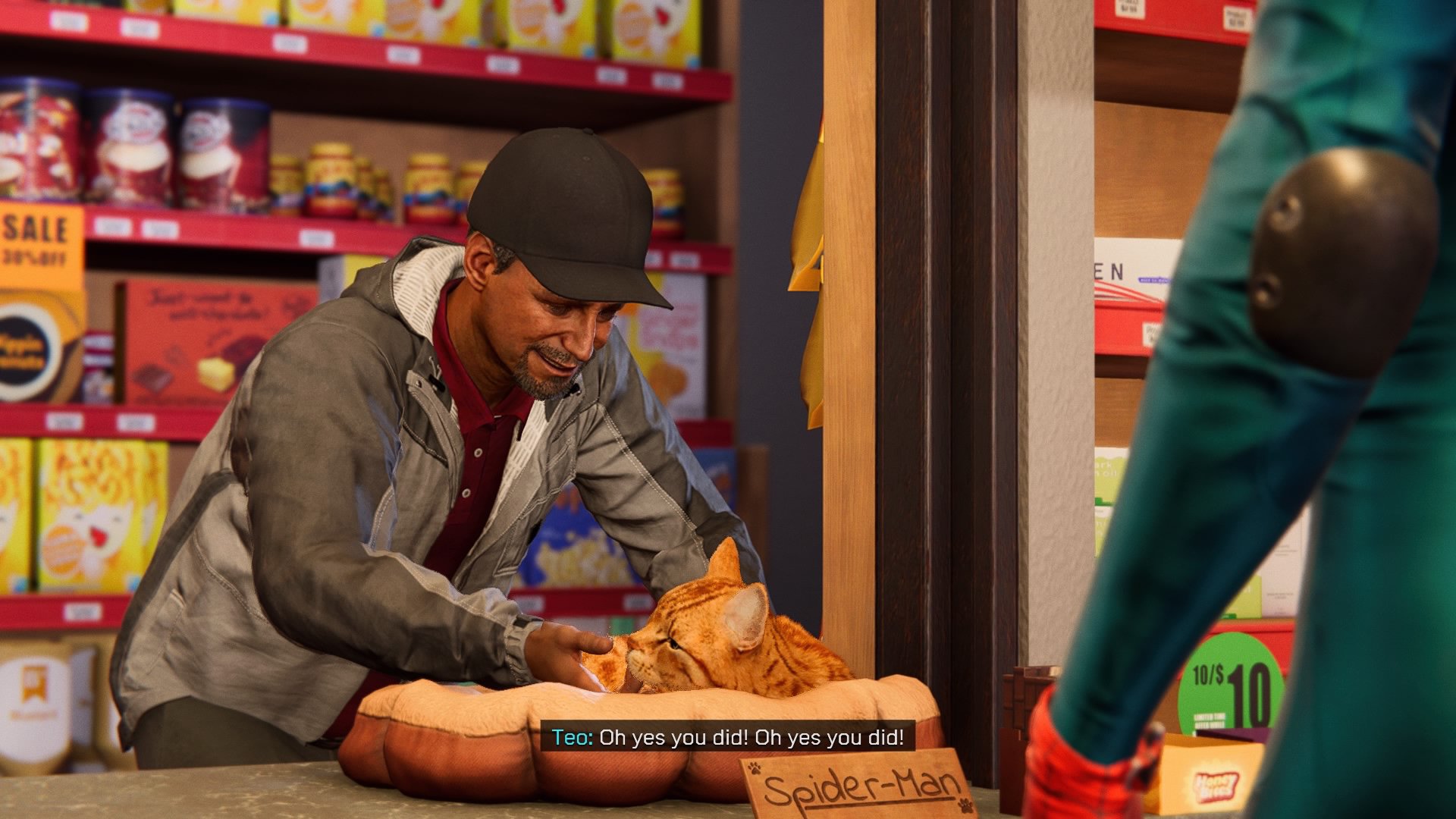
The core gameplay iterates heavily on the original game; players will once again guide their Spider-Man through an open-world New York City, taking on cinematic story-based missions and procedurally-generated random crimes in equal measure. Web swinging still feels intuitive and joyous like nothing else in gaming, and combat is still a frantic mix of strategic pre-brawl planning and chaotic mid-fight calibrations to address new threats. Miles’ new powers add a dose of stealth and risk-reward mechanics to fights, but no one has reinvented the Big Wheel here. Old fans can sink right back into the flow like a warm bath after a hard day (or a hard year, let’s be real), and newcomers will jump right into an opening half hour that condenses everything I love about Spider-Man into a prologue filled with action, comedy, and heart.
Set roughly a year after the conclusion of Spider-Man (complete with a “Previously On” recap option to set the tone), the story introduces us to a Miles Morales deep into his superhero training alongside Peter Parker. It’s the night before Christmas, and after thwarting an escape attempt from Rhino and discovering a new, electricity-based quirk to his Spider-Powers, Miles is thrown for an even bigger loop: Peter and MJ are taking a long-overdue work vacation to Europe, and the newbie Spider-Man will now be the only one in New York City over the holiday season.
To love Spider-Man, as a character and as a concept, is to love Peter Parker. But that built-in love from the audience is always a sticking point for Miles Morales stories, which need to find a way (usually, a tragic one) to remove Peter so another Spidey can get the chance to shine. Sending Pete overseas to Symkaria is a smart way to reach this same outcome, and within the first hour the player (and Miles) truly feels alone. Naturally, super-crimes follow. But this time, they feel like digressions from the best parts of the game’s story. I slowly found myself wanting to punch less and talk more.
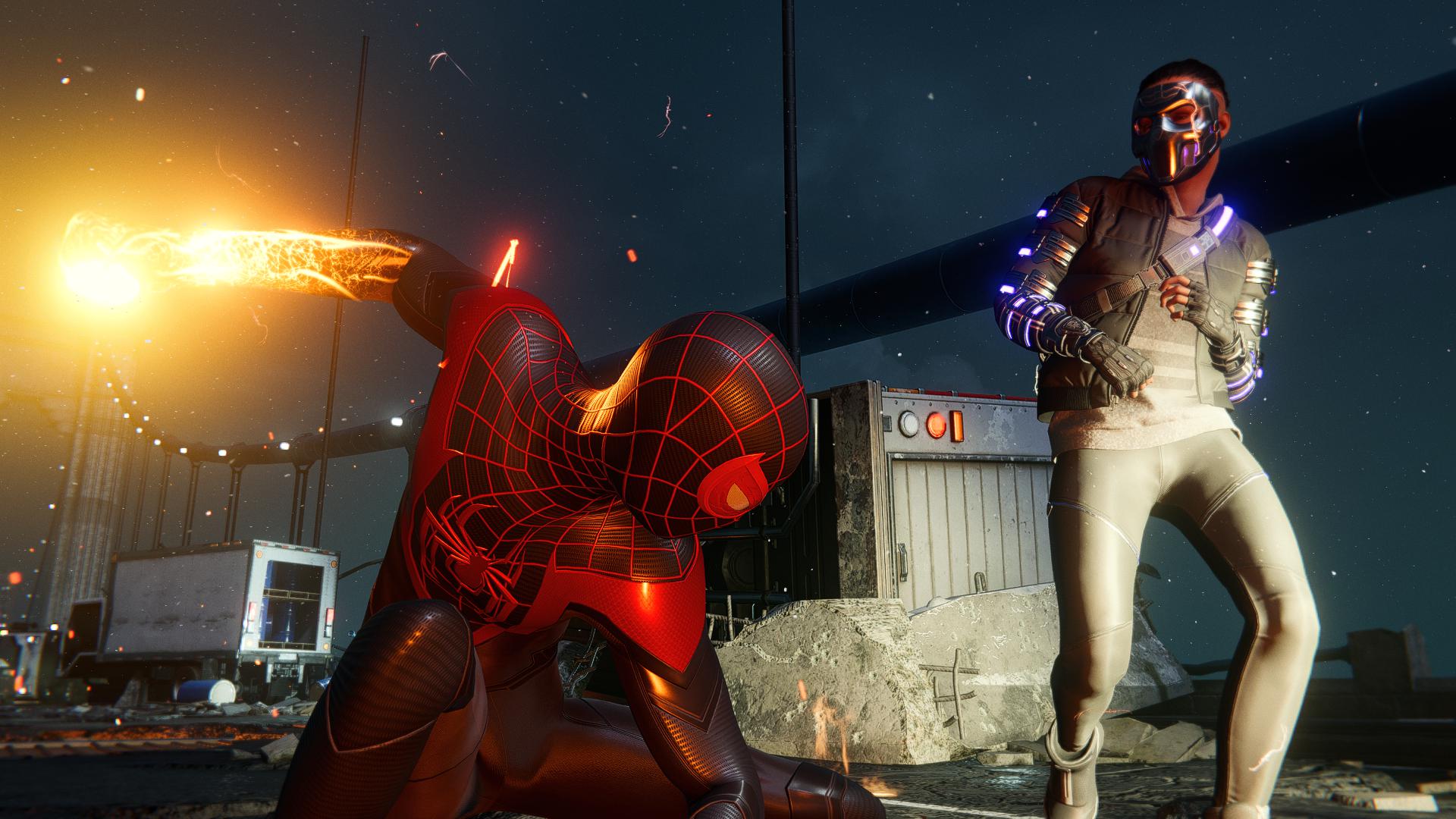
At the start of the game, Miles and his mother, Rio, have moved into his abuela’s old apartment in Harlem to recover from their family’s tragic losses the year before. Ganke Lee, Miles’ best friend from high school, is staying with them over winter break, turning them into a makeshift family unit. These dynamics are perfectly sketched out during a Christmas Dinner scene where the player helps Miles navigate family time and covert wall-crawling to restore power to their building. Rio is running for City Councillor; Ganke is developing a video game. Every single character in Miles Morales has something they believe in and are fighting for. Spider-Man stories don’t work if the interior lives of their characters aren’t acknowledged; the gut punch of missing dinner with a friend needs to land just as hard as a closed fist from a supervillain to sell the struggle of a web-slinger’s double life. But inevitably, the game gives you someone to punch.
The main storyline of Miles Morales involves yet another formerly-obscure gang, The Underground, and their violent campaign to wage war against the monolithic energy conglomerate, Roxxon. A new supervillain, The Tinkerer, drives much of the story as their influence over The Underground (and hatred of Roxxon) leads to plot twists and explosions in equal measure. Miles doesn’t face off against as many villains as Peter did in the previous game, but every rogue in his gallery makes a strong impression and serves a purpose in his path to becoming a superhero on his own terms. Earning the respect of your community doesn’t come from your ability to tie violent offenders up in webbing, it comes from being a Friendly Neighbourhood Spider-Man.
So I guess it’s time to talk about cops.
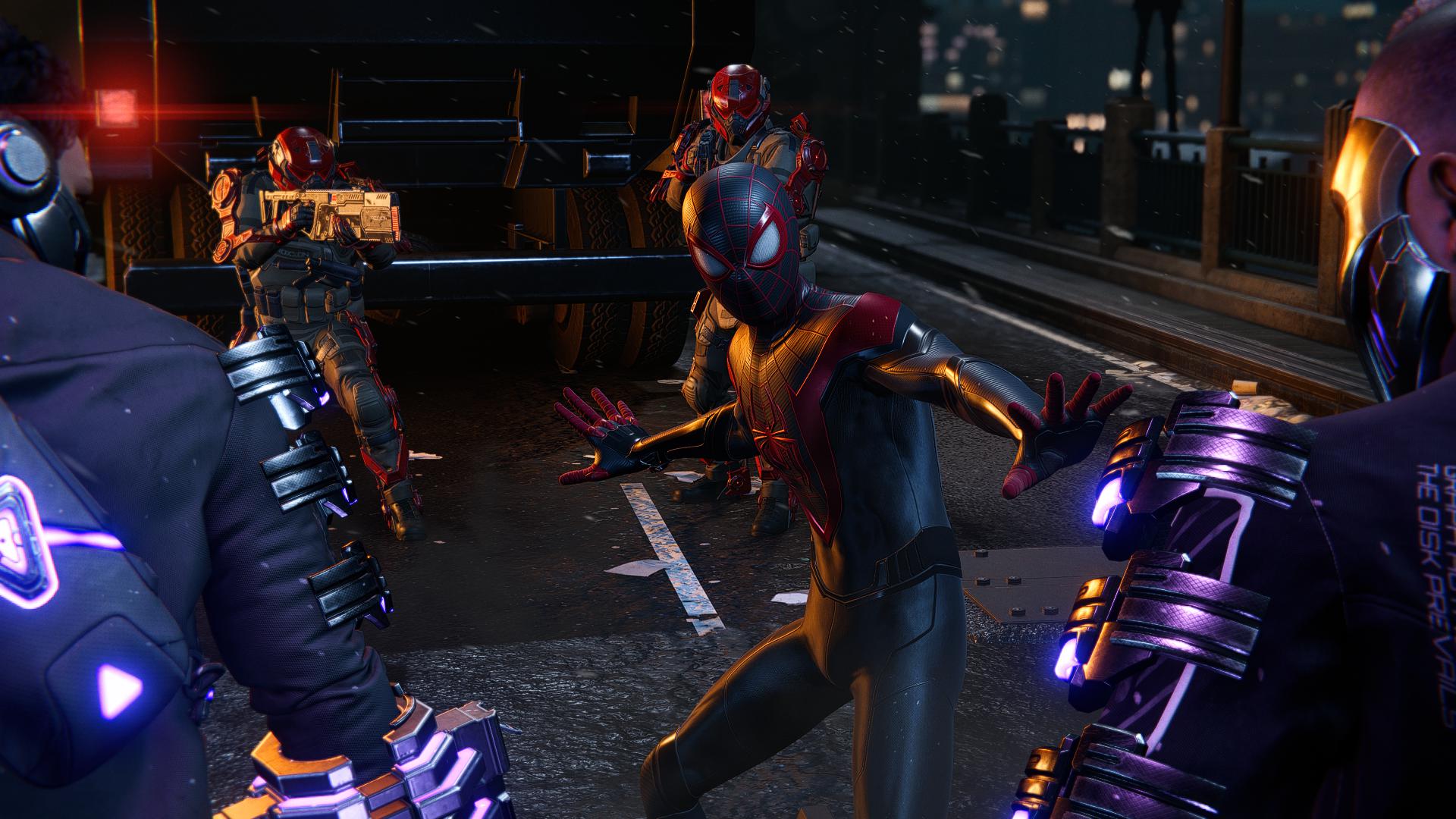
The problems and criticisms of the original game’s relationship with policing are well-publicised, and I felt them personally during my initial playthrough two years ago. They felt tone-deaf back then, a strangely stubborn declaration that in The Marvel Universe, the problems raised by institutional racism and the role police can play in upholding it were practically non-existent. In 2020, that position would be incoherent for a game set in contemporary New York City. So Miles Morales, unintentionally or not, goes in a different direction..
Despite his father’s (who is never portrayed as anything less than a saint) career as an officer in the PDNY (a change to the real-world acronym that feels purposeful), cops don’t play a major part in Miles’ life. He’s a mixed-race Black and Latinx teenager, and the game never asks us to do the mental gymnastics to justify why he would be exceedingly pro-police. Instead, early in the game, Ganke finishes the Friendly Neighbourhood Spider-Man (FNSM) App, which feels like a mix between Nextdoor and Postmates. New Yorkers share problems they’re having, or crimes they’ve witnessed, and Spider-Miles swings by to see if he can help. It feels just right for how a brilliant, tech-fluent teenager would want to communicate with his city today, and it shows us Insomniac’s solution to the Spider-Cop Problem: Community Service.
After thwarting a random bodega robbery, I heard Miles insisting he should leave before the cops show up, because they “weren’t big Spider-fans.” Later in the game, a character reveals that Miles’ father, Jefferson Davis, joined the police to try to change it from within, and “probably died trying.” This is a game that realised it could not ask players to feel like Miles Morales without considering how he would feel about the police.
Or how the police would feel about him.
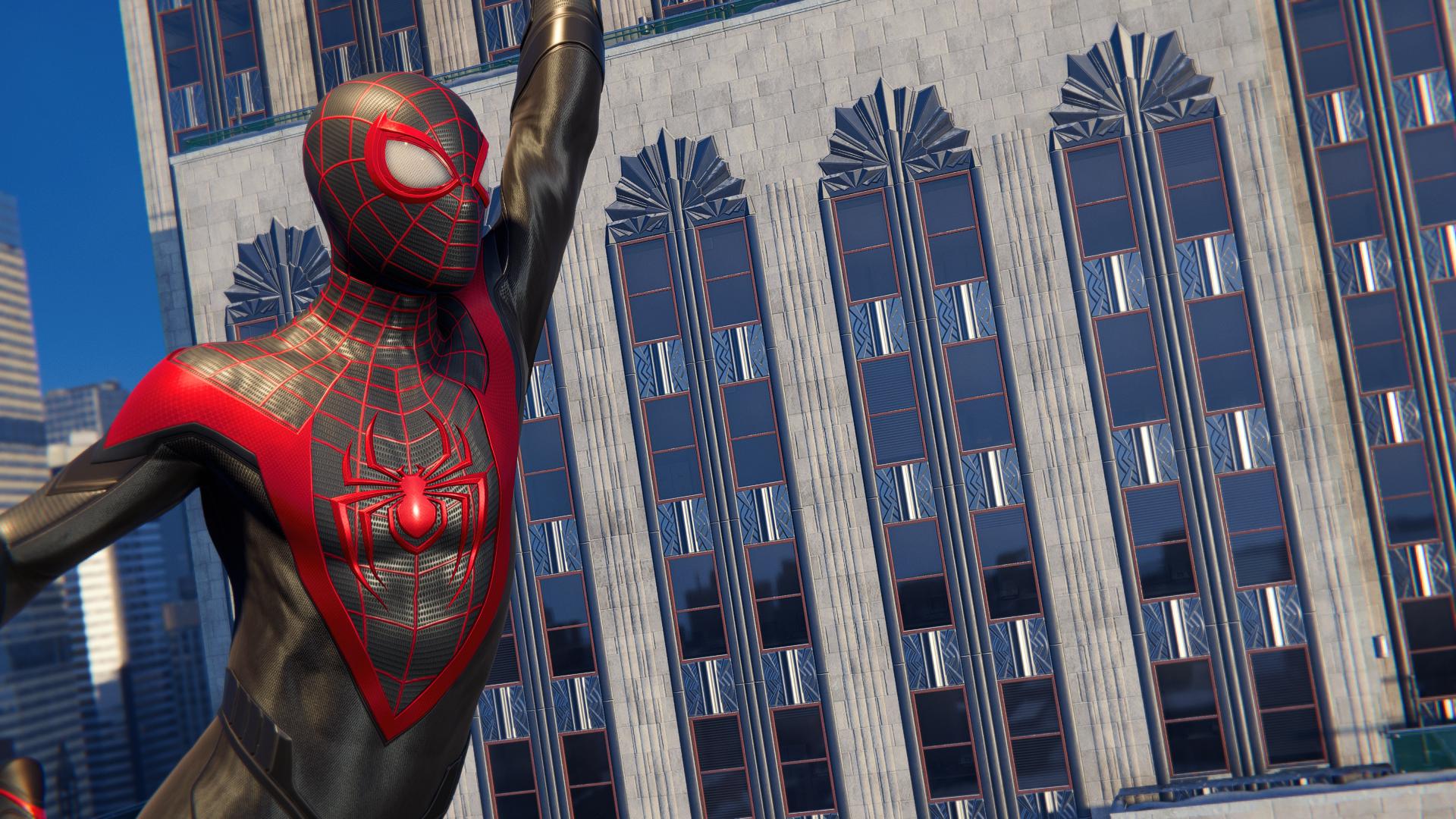
It’s a truism to the point of parody that a superhero video game “Makes You Feel Just Like X.” And yes, obviously releasing your web at the top of your parabola, doing a double backflip, landing on a streetlight, and then webbing a gun-toting gang member to a wall makes me feel like Spider-Man.
But read the title. This game wants you to feel like Miles Morales. In its absolute best moments it succeeds like few games I’ve ever played.
In that same early-game Christmas dinner scene, Rio asks Miles to select an album from his dad’s record collection to play during the party. After digging through three boxes, the player can choose from three records: “Moanin’” by Miles Davis, “Esta Navidad” by Willie Colón, and “Merry Christmas Baby” by Otis Redding. There’s no wrong answer here, but it felt like each record spoke to a key family member in Miles’ life, and the player was given the choice to code switch between those different worlds. Once again, I have been that mixed-race teen leaning into different sides of his heritage. I went with Otis Redding. Later on in the game, you can put on another track as you hang around at home. I sampled Willie Colón that time. No wrong answers.
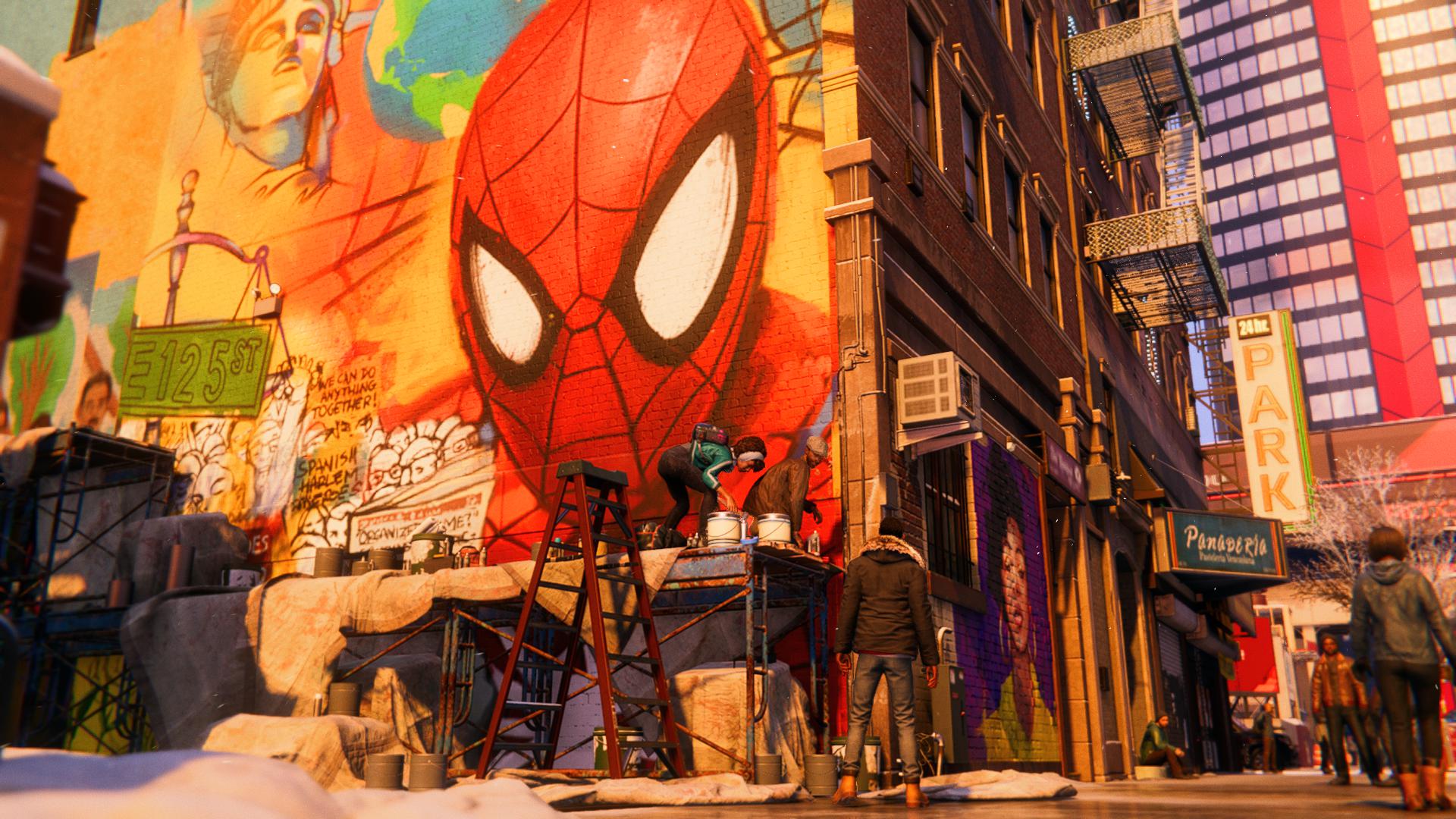
The game’s best side quests are equally intimate, showing us how Miles and the people he loves have left their mark on the city. From geocaching for old time capsules, to an audio scavenger hunt to stitch together an unfinished hip hop beat, these missions are similar to Peter Parker’s lost backpacks in the original game. But while those backpacks mostly served as an easter egg delivery device for tons of sly Spidey references Miles’ collect-a-thons feel like love letters. While the usual rewards for finding them all are still here (I can confirm the two dozen suits to collect completely rule), by the end of each quest I felt far more satisfaction from how I came to better understand Miles, the people in his life, or the relationships between them. It helped me see the city through his eyes, and my other senses followed.
Early in the game Miles catches half of a predictably-furious rant from J. Jonah Jameson before he does something Peter Parker never could: he changes the channel to Danika Hart, a teenage podcaster whose mix of bubbly self-care tips and sincere citizen journalism are a far cry from the conservative ragefest of JJJ’s show. When swinging around the city and webbing up bad guys, the soaring adaptive orchestral soundtrack from the first game has been chopped and screwed into a perpetual beat. Strings roar to life alongside snare hits when Miles lays a punch or jumps off another building. Throughout the story, we are continually shown that beats and music are truly a part of his world. It makes sense that they’re the core of his superhero theme, too.
Since it’s technically a next-gen launch title, Miles Morales seems like it was purpose-driven to showcase graphical flourishes as much as possible. (I played on a standard PS4, but this is very much the star of the PS5 launch lineup as well.) Multiple missions in the game take place during light snowfall or heavy blizzards, and the on-screen action was smooth as butter. When you select a gadget or open your App menu, the game slows down enough to let you count individual snowflakes. Miles’ unique Spider-powers take the form of orange electricity, adding another layer of pyrotechnics to every battle. And make no mistake: you’ll be using those electricity powers a lot.
Miles feels weaker than Peter Parker, and I’m not sure if that’s by design or due to my own average action-gaming skills. His powers (turning temporarily invisible and unleashing powerful electric strikes once he’s built up enough metre) are integral to every puzzle and enemy engagement past the start of the game. Your main enemies share the gimmick of being able to change their weapons on the fly, which means you can find yourself surrounded and defeated in a matter of seconds if you don’t plan your moves right.
I died at least once in every major story mission, and eventually defaulted to taking out a few enemies while invisible, retreating to the rafters to recharge, and repeating the cycle until a room was cleared. Your mileage may vary, but I’ve always felt that Insomniac’s approach to stealth gaming works better in theory than it feels practice. But even those powers help me feel more like Miles Morales; he first gains the ability to turn invisible while standing with his hands up asking a half-dozen gunmen not to shoot.
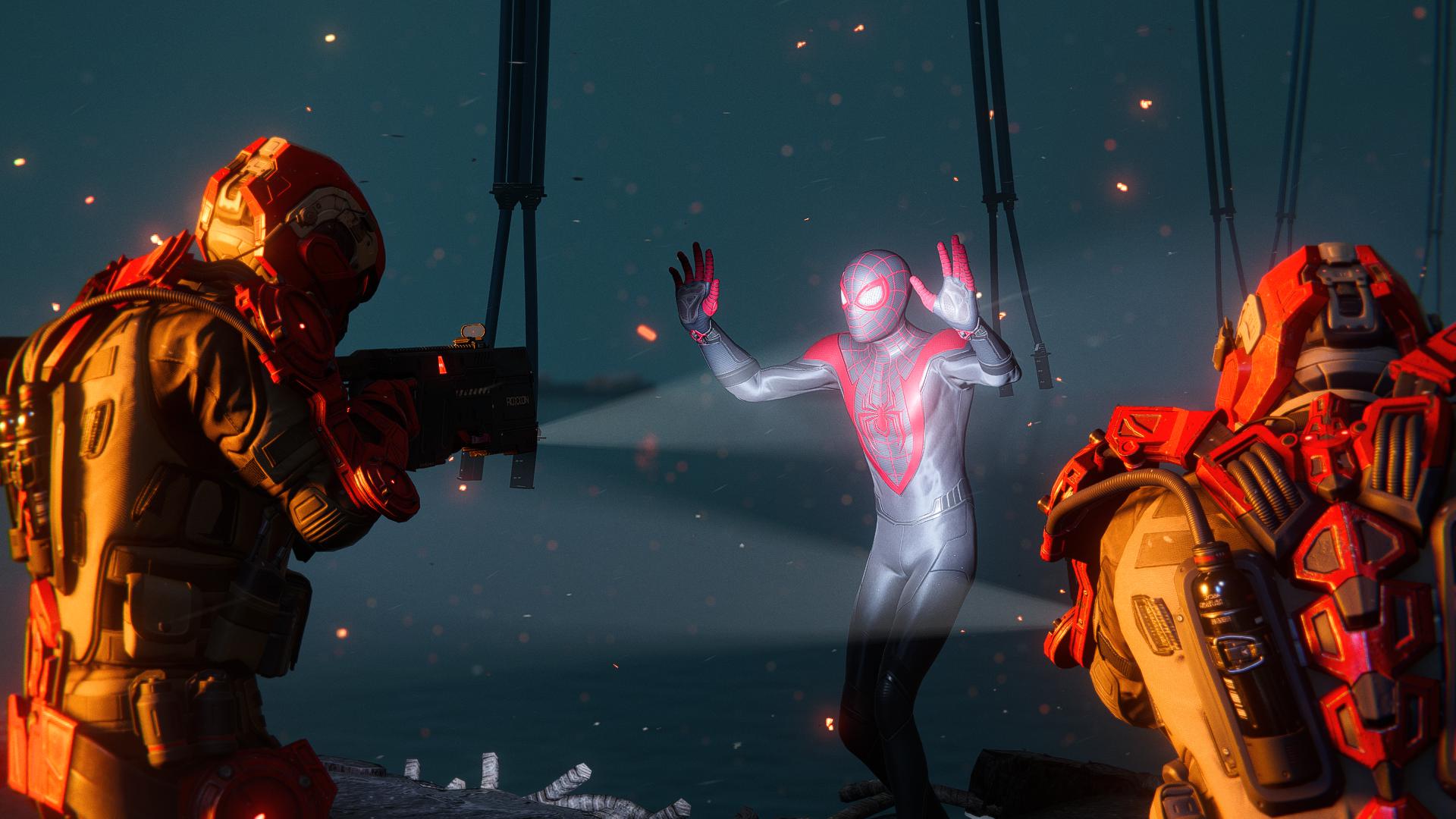
Because of Sony’s restrictions tied to being able to review the game in advance of release, I’m not allowed to discuss the main characters and villains of Miles Morales, but most of the game revolves around how Miles struggles to connect with and understand both groups respectively. The voice cast is uniformly fantastic; Yuri Lowenthal does a lot with a little in his repeat performance as Peter Parker, and Nadji Jeter brings warmth and heart to Miles, a role he’s held since 2017’s Spider-Man animated series.
Some of those unnameable characters are portrayed with nuance and power by Jasmin Savoy Brown (The Leftovers), Ike Amadi (Knack), and Todd Williams (The Chicago Code), and all of the game’s most emotionally resonant moments land because of them. At the same time, industry heavyweights like Troy Baker and Ashly Burch bring side characters like Simon Krieger and Danika Hart to life with smarm and charm, respectively.
Miles’ voice lines were recorded twice, and are switched out depending on whether the player is resting or web-swinging while he speaks. Every single time you shoot webs, a tiny “thwip” sound comes out of the controller/your wrists. As reported Miles is wearing Adidas in his starter outfit, but to their credit, they look exactly like a pair of track-worn Adidas. This is a game that wants you to care about the tiniest details and moments, because its ultimate thesis is that Miles isn’t just Spider-Man; he’s the Spider-Man that looks and sounds like New York City in a way Peter Parker doesn’t.
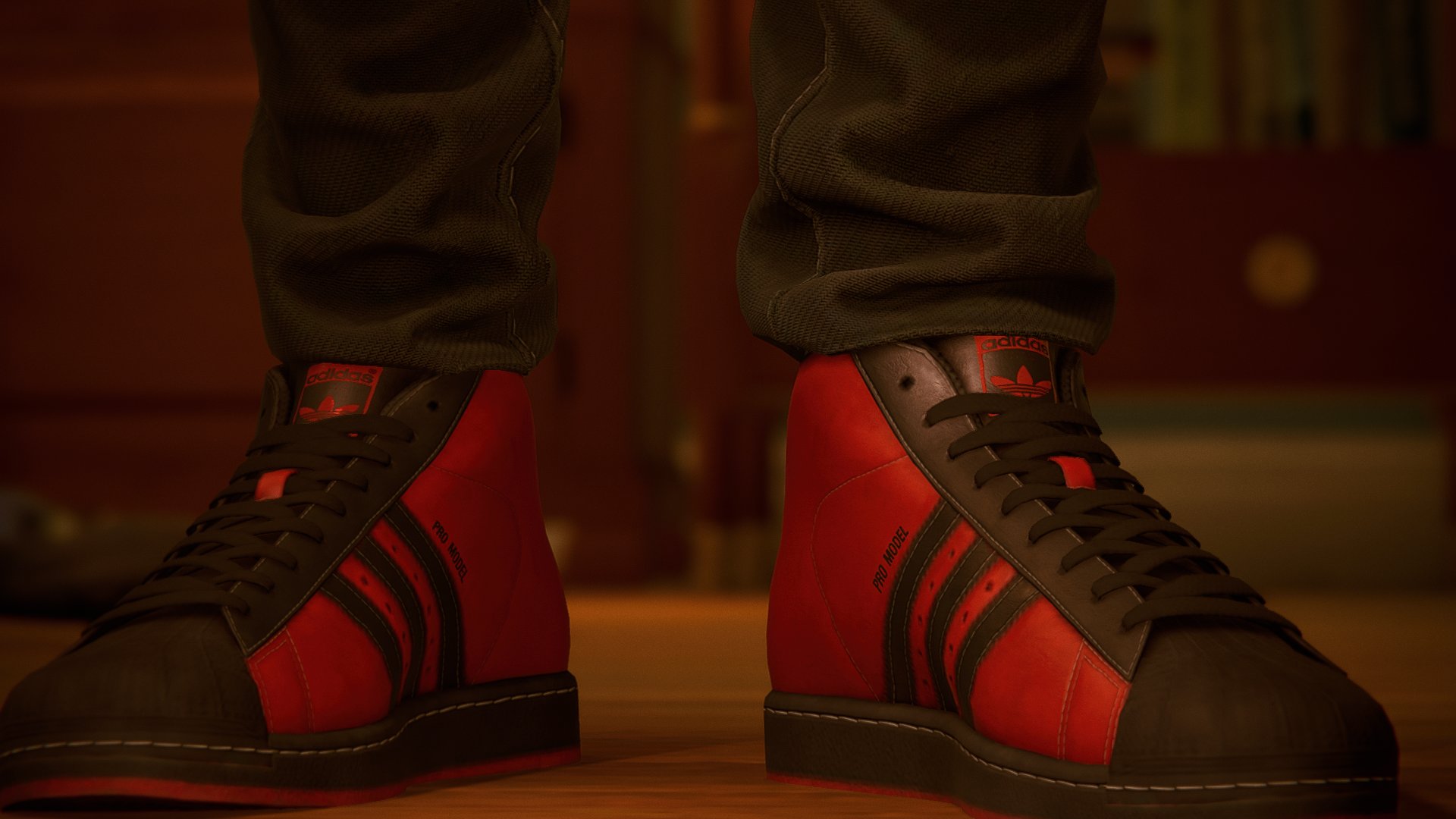
Just as Miles’ amateur style of web swinging leads to much more spinning and flailing than Peter’s polished form, this is where Miles Morales slips and falls at the height of its arc. Because I was so impressed with the tiny details, the missing pieces stood out even more.
Miles’ bedroom looks exactly like you would expect, until you look at the posters on his wall. Near his door, a legally-distinct-from-Michael-Jordan basketball player leaps towards the net surrounded by the words “FIGHT WELL STAY STRONG.” As an avid hip hop fan, it makes sense that you’d find some rapper’s poster in his room; instead, there’s just a monochromatic shot of a nonspecific rapper above the words “New York HIP HOP.” The shape is there, but the texture has been filed off, probably for licensing reasons.
But what happens when you similarly sand down the texture of the entire neighbourhood that Miles is ostensibly fighting for? (Note: I’m not from Harlem; I’m a Canadian who has visited NYC twice as a tourist and hit up Harlem for waffles.) Miles Morales wants to tell the story of how its main character comes into his own as a superhero by embracing what makes him different, and finding the people he can fight for. It wants to show us how he grows to love and respect his new neighbourhood (and how his neighbours do the same for him in turn) by helping them with problems big and small. The best moments of the game are when supervillains and dramatic reveals are sidelined for moments of human decency and an obscenely-loveable cast of bodega owners, barbers, and people looking out for each other.
However, it all happens too fast and too infrequently. Within a handful of hours (and an even smaller number of missions) I went from meeting these people for the first time to watching Miles declare he would do anything for them. I got the impression that certain local landmarks (a park, a bodega) were supposed to burn themselves in my mind forever, but I always had to resort to the mini-map to find my way around. I was told I was playing as the Spider-Man of Harlem, but I spent most of my time in the skies and rooftops of the borough as a whole. I wanted to slow down and build the relationships the game was all too quick to sketch out in shorthand. But this is a superhero story, and superhero things had to happen.
[review heading=”Spider-Man: Miles Morales” image=”https://www.kotaku.com.au/wp-content/uploads/sites/3/2020/11/07/a1hgxprsibarzopwxq1e.jpg” label1=”Back of the Box Quote ” description1=”“There are no good optics for destroying a child.”” label2=”Type of game” description2=”Spider-gig economy simulator” label3=”Liked” description3=”A refinement of the mechanics and gameplay loops of 2018’s game, excellent and genuinely touching sidequests and plot moments, web swinging is so fun it feels wrong in 2020.” label4=”Disliked” description4=”Combat can become a hectic trial-and-error situation, the main storyline ends up feeling generic and safe compared to other moments, not enough Harlem.” label5=”Developer” description5=”Insomniac Games” label6=”Platform” description6=”PlayStation 4 (played), PlayStation 5″ label7=”Release Date” description7=”November 12″ label8=”Played” description8=”20 hours, completing 100% of missions on Amazing difficulty and getting the Bodega Cat outfit” ]
Basically, I wish Miles Morales’ Harlem was like the Yakuza franchise’s Kamurocho. I would vastly prefer more lowkey interactions to build my understanding and affection for this neighbourhood over the dozen-or-so sidequests and action setpieces I was given instead. Despite the everyman archetype, Insomniac’s Spider-Man just isn’t that type of street-level hero. I understand my wish for a smaller, slice-of-life approach to one of the most recognisable fictional characters on Earth is probably a weird one.
But I feel like Insomniac wanted to go that way, too. Because of a mural.
Once you finish all of the non-procedural sidequests in the FNSM App (something I pulled off after 10 hours or so), Miles is given one final task: head to a parking lot in the Financial District where grateful people in the city have left him a gift. It’s a sweet moment that drives home the love and support Miles has earned on his own. And then you wind up in front of a gigantic five-story Black Lives Matter mural.
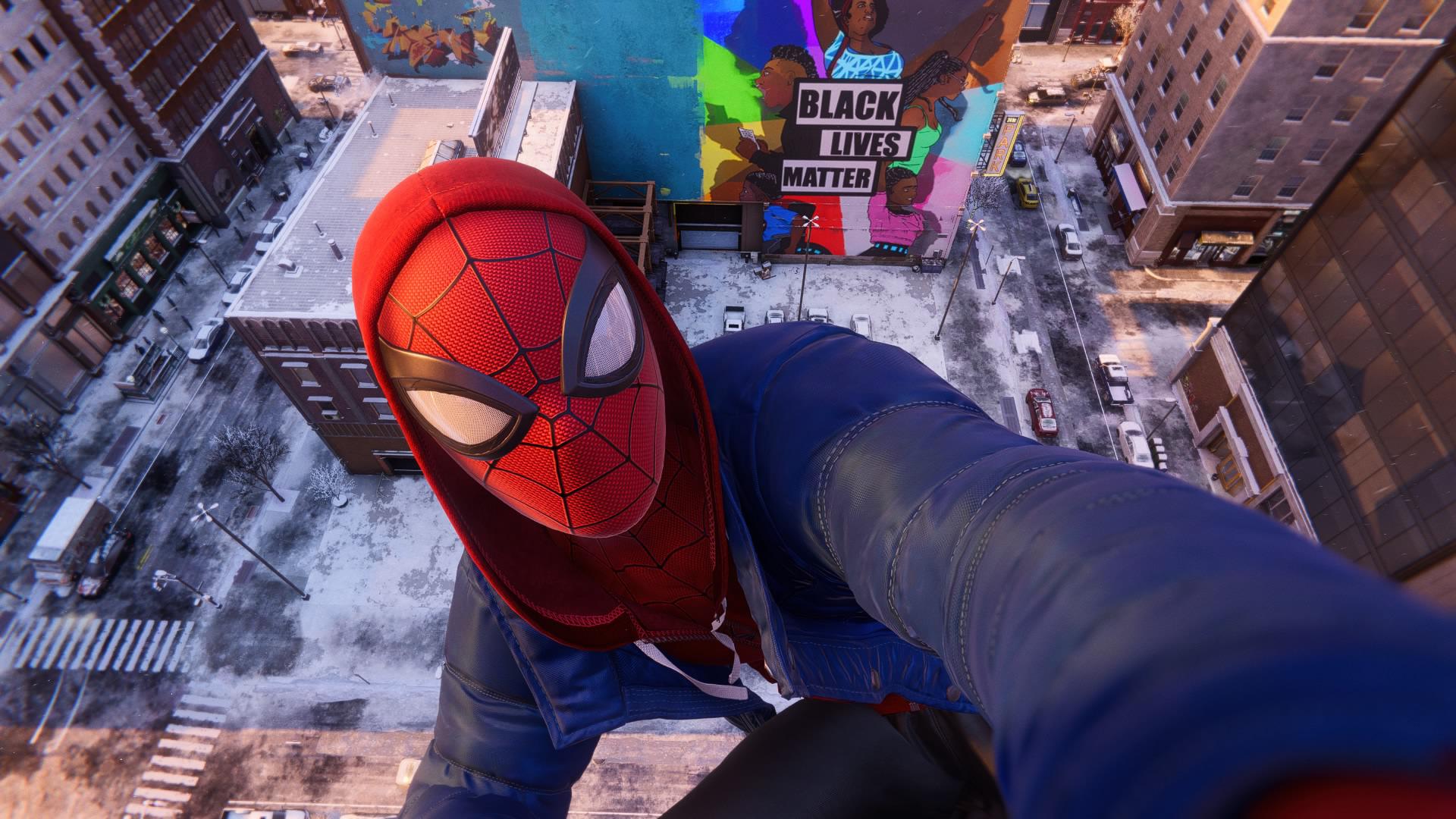
I’m pretty sure this is the first acknowledgement of BLM in a video game ever. While the games industry blasted off messages of support in varying levels of quality and sincerity this past summer, I can’t think of a high-profile game that has taken the step to canonically acknowledge, and by extension immortalise, this movement and the moment in history it signifies. The mural is always there; you can seek it out as soon as you’ve finished the first introductory mission. But the game knows what it’s doing by putting this gift of gratitude in front of that image. You cannot finish all the sidequests or acquire every suit without seeing the mural. It’s a statement.
Superhero stories have always struggled to effectively portray problems that can’t be punched in the face, usually only acknowledging real-world societal issues when they’re inescapable or undeniable. To be a Black fan of comics, you have to calibrate your expectations on the low end and expect to deal with stereotypes and gaffes from even your most beloved creators. I truly didn’t expect Miles Morales to approach even half of the issues it broaches, ending on a note that I can only describe as a celebration (and lowkey analysis) of Black Excellence in several forms. It’s not perfect, but it’s something.
And that’s how I feel about the mural. If BLM exists in Marvel’s New York City, so too must the millions of injustices and tragedies that transformed a fact of life into a rallying cry. Harlem in Miles Morales is a neighbourhood on the edge of multiple types of eradication, from financial, to cultural, to (eventually) physical. The game borrows and references visual moments and plot beats from almost every Spider-Man movie to date in its attempt to paint Miles as Harlem’s champion. But not all of the problems he’s fighting can be webbed away, and he’s just a kid. The mural serves as a testament to that dichotomy: whether it’s our New York City or Miles’, Black lives are inescapable and undeniable.
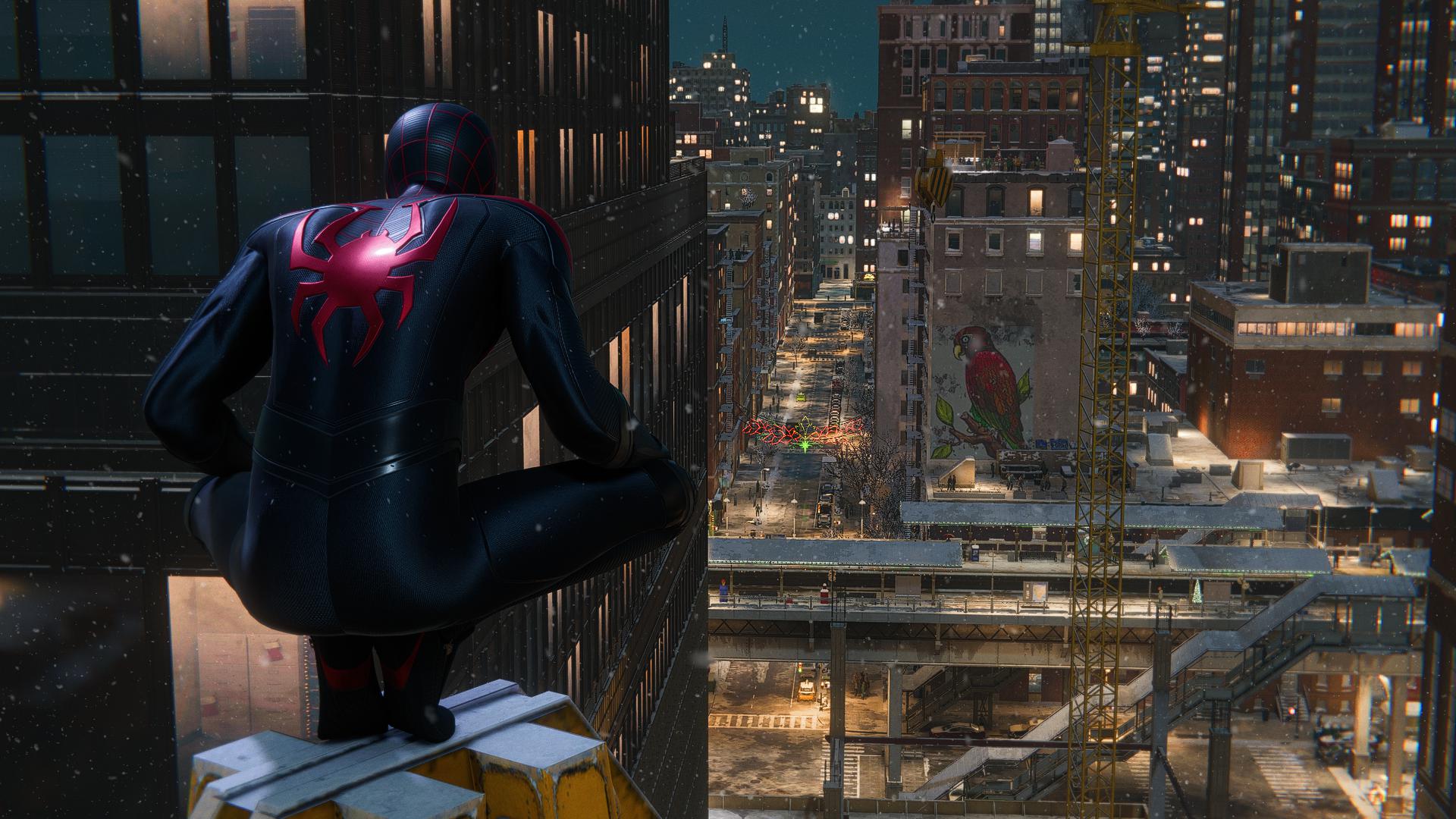
One of the most unexpected surprises I found while playing Marvel’s Spider-Man in 2018 was how willing the story was to dip into the outright tragic and invest in the emotional lives of its characters in a way few superhero games had done at that point. Miles Morales takes equally huge emotional swings across its story, but it ends on an epilogue of unambiguous hope and joy. That, too, hits different in 2020.
Marvel’s Spider-Man: Miles Morales is a beautiful game with a big heart, weighed down by the obligation inherent to all the names in its title. In its absolute best and most joyfully surprising moments, it reminds us that cities are shared spaces with overlapping stories. It shows us that the opposite of web-swinging through Manhattan isn’t stealth setpieces and fight scenes with dozens of enemies, but chatting with your deaf/hard-of-hearing neighbour using sign language. It plays, looks, and feels like the game it evolved from, but it has aims that are both bigger in theme and smaller in scope.
It takes a hard look at problems and stories that don’t involve punching, but ultimately becomes a Story About Punching. It’s a game that feels short not from a lack of open-world icon-hunting busywork, but because its final moments ask us to invest in spectacle and rushed plot resolutions after a dozen hours of treating us to human-level substance. Miles Morales excels in its smallest moments, and I wish it had the confidence to stand by them to the end. Maybe next time, True Believers.
Editor’s note: Kotaku readers might be particularly interested in knowing that our former longtime colleague, Evan Narcisse, was one of the writers on this game.
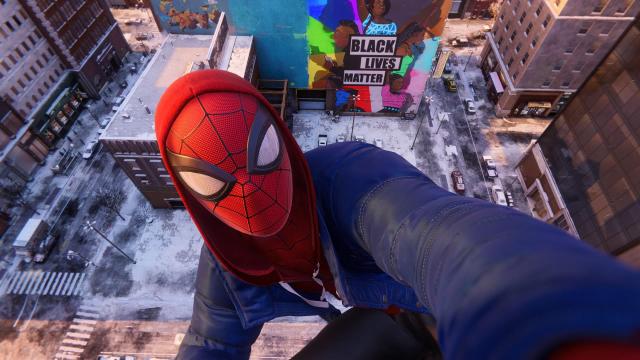
Leave a Reply